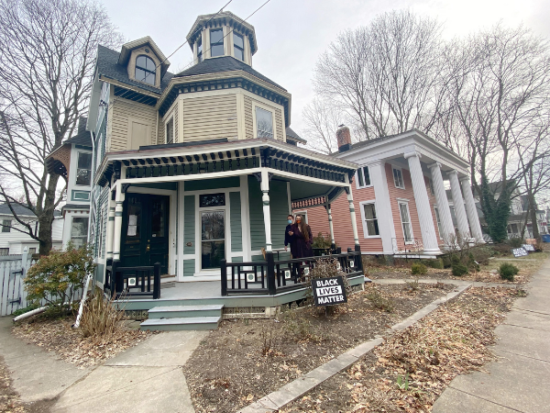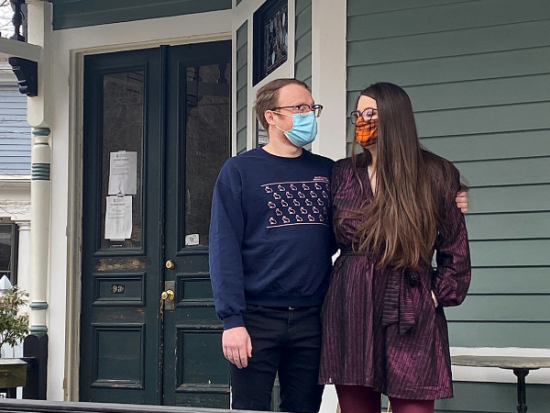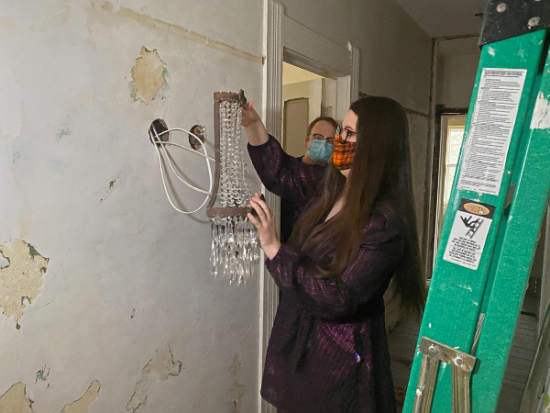Cheap Old Homes Draw US Millennials Escaping Pandemic Cages
American millennials with budget constraints break out of their pandemic coops to find affordable dream homes in far-flung places.
For funeral home director Kate Reinhart, from Utah, that dream is an octagonal Victorian that recalls the macabre Addams Family mansion seen in cartoons, films, and a TV series.

Kate and Cameron Reinhart stand on the porch of their 1880’s Octagon house they are renovating during the coronavirus pandemic, in Norwich, eastern Connecticut, U.S., January 14, 2021. REUTERS/Dan Fastenberg
It helped that her scientist husband Cameron found his first job near Norwich, Connecticut, a town with one of the largest concentrations of 18th- and early 19th-century houses in New England.
For just $85,000, the couple bought the 1885 house replete with stained glass, artisanal light fixtures, and winding banisters. They plan to put some $100,000 into a massive renovation.
“I do feel like we appreciate it more now during the pandemic to have more space to ourselves,” Kate said. “People are more self-conscious about being on top of each other in tiny apartment buildings. In New York City, people are fleeing to here.”
The Millennials Trend
The trend is clear from visits to CheapOldHouses, a website founded by Elizabeth Finkelstein in 2016 to promote historic houses’ purchase and preservation.
Followers of the site’s Instagram account have steadily doubled every week since U.S. pandemic lockdowns began in March, to about 20,000, she said. About 42% are aged 25-34, and about 75% are women.
“The mantra of real estate has always been ‘location, location, location.’ For the first time, that’s being flipped a little bit on its head,” Finkelstein said. “We are living in a time when people are willing to kind of take risks, maybe risks that they’ve wanted to take their whole life.”

Kate and Cameron Reinhart stand on the porch of their 1880’s Octagon house they are renovating during the coronavirus pandemic, in Norwich, eastern Connecticut, U.S., January 14, 2021. REUTERS/Dan Fastenberg
Homes on CheapOldHouses.com tend to be in the U.S. Midwest, South, and Rust Belt, where many sell for less than $100,000. Houses that cost more in North America, Europe, and elsewhere are also listed in Finkelstein’s monthly newsletter.
“We feature homes people can realistically buy, but also use their hands-on as opposed to sitting in a cubicle all day long,” she said.
A net 70,000 people left the New York metropolitan region in 2020, resulting in roughly $34 billion in lost income, estimated Unacast, a location analytics provider.

Kate and Cameron Reinhart are seen in their 1880’s Octagon house they are renovating during the coronavirus pandemic, in Norwich, eastern Connecticut, U.S., January 14, 2021. REUTERS/Dan Fastenberg
More millennials may leave big cities even after the pandemic is over, Finkelstein said.
“With so many offices going remote, people have more opportunity to say, ‘maybe I don’t need to be paying more than half my income in rent. And I can, I can take that leap.'”
(Reporting by Reuters Television; Writing by Richard Chang; Editing by Rosalba O’Brien)

